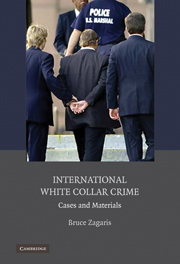Book contents
- Frontmatter
- Contents
- 1 Introduction
- 2 Taxation
- 3 Money Laundering and Counterterrorism Financial Enforcement
- 4 Transnational Corruption
- 5 Transnational Organized Crime
- 6 Export Control and Economic Sanctions
- 7 Extraterritorial Jurisdiction
- 8 International Evidence Gathering
- 9 Extradition and Alternatives
- 10 International Prisoner Transfer
- 11 The United Nations
- 12 The World Bank Group
- 13 INTERPOL
- 14 Economic Integration and Business Crimes
- Index
- References
14 - Economic Integration and Business Crimes
Published online by Cambridge University Press: 05 June 2012
- Frontmatter
- Contents
- 1 Introduction
- 2 Taxation
- 3 Money Laundering and Counterterrorism Financial Enforcement
- 4 Transnational Corruption
- 5 Transnational Organized Crime
- 6 Export Control and Economic Sanctions
- 7 Extraterritorial Jurisdiction
- 8 International Evidence Gathering
- 9 Extradition and Alternatives
- 10 International Prisoner Transfer
- 11 The United Nations
- 12 The World Bank Group
- 13 INTERPOL
- 14 Economic Integration and Business Crimes
- Index
- References
Summary
Introduction
Economic integration plays an important role with respect to transnational white collar crimes, although for the most part, governments concluding free trade agreements (FTAs) and economic integration agreements have seen that element as an afterthought. Persuading legislatures to overcome nationalist sentiments and limit sovereignty in order to support the negotiation and ratification of FTAs or single markets consumes significant political capital. The decision to include regulatory – let alone criminal and quasi-criminal measures – within an FTA or single market arrangement is not taken lightly.
As a result of political decisions to minimize criminal and enforcement institutions and mechanisms when sovereign states enter into an FTA, common market, or an economic integration arrangement, criminals are often quick to identify and exploit opportunities to enlarge their illicit operations. The lowered barriers allow them to conduct crime transnationally.
In some cases signatories include criminal and enforcement provisions and mechanisms relating to one or two economic sectors in FTAs and single market arrangements. For instance, as noted later, due to intense and successful lobbying by U.S. intellectual property interests, NAFTA provisions cover intellectual property and customs enforcement.
The relationship among economic integration, international criminal and enforcement cooperation, and criminal justice integration is thus ambiguous and complex. Yet, all involve state responses to increases in transnational interactions among nonstate actors and try to mitigate the tensions and frictions that hamper efficient cross-border interactions.
Successful criminal justice systems require three elements: information, evidence, and the accused or convicted person.
- Type
- Chapter
- Information
- International White Collar CrimeCases and Materials, pp. 515 - 562Publisher: Cambridge University PressPrint publication year: 2010



